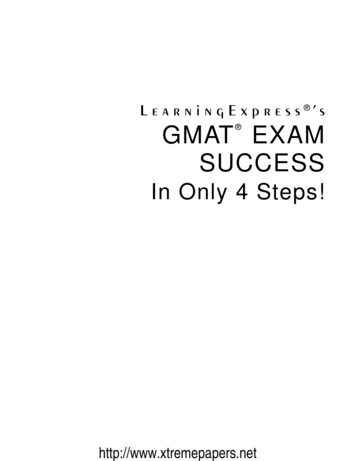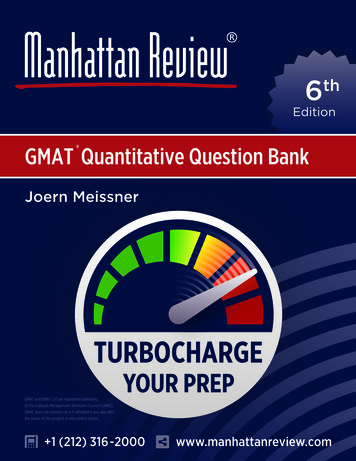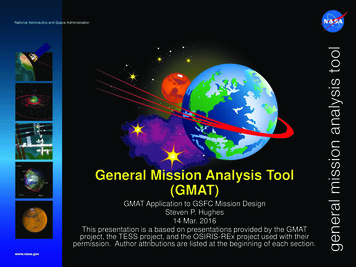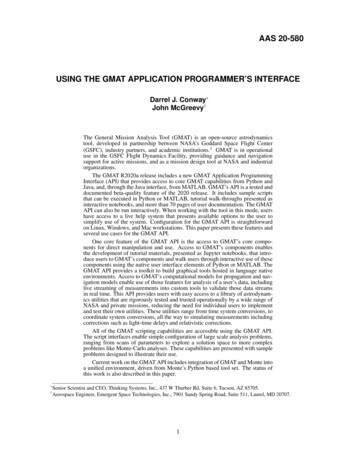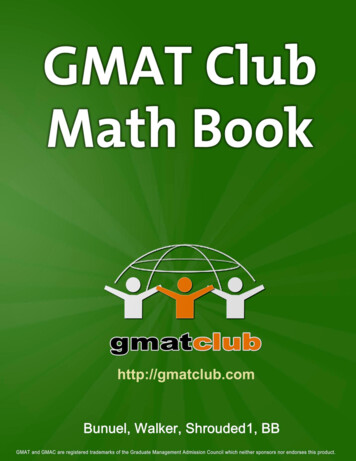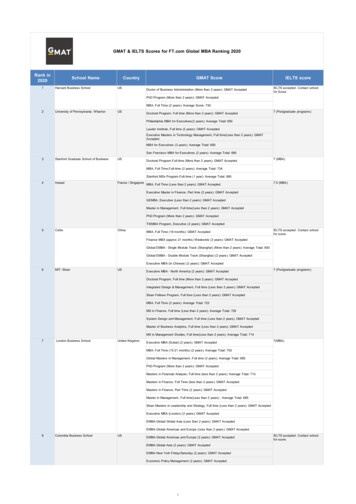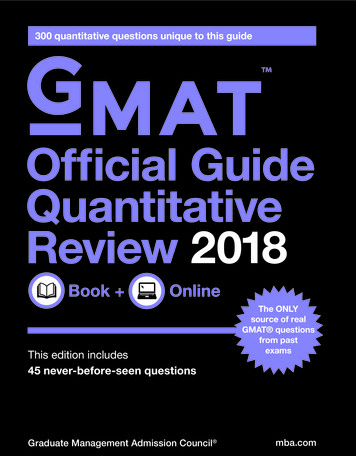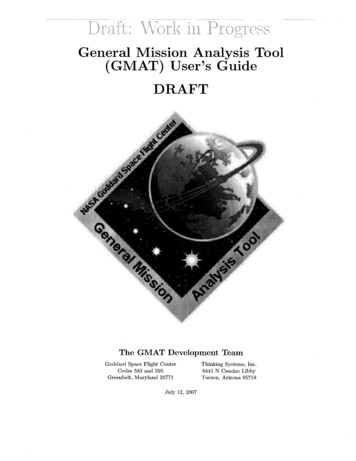
Transcription
General Mission Analysis Tool(GMAT) User's GuideDRAFTThe GMAT Development TeamGoddard Space Flight CenterCodes 583 and 595Greenbelt, Maryland 20771Thinking Systems, Inc.6441 N Canlino LibbyT i c s o nArizona 85718
Contents1 Configuring Objects/Resources1.0.1 Overview of the Spacecraft Object . . . . . . . . . . . . . . . . . . . . . . . . . . . . . . . . . .1.0.2 Spacecraft Orbit Tab . . . . . . . . . . . . . . . . . . . . . . . . . . . . . . . . . . . . . . . . . .1.0.3 Spacecraft Attitude Tab . . . . . . . . . . . . . . . . . . . . . . . . . . . . . . . . . . . . . . . .1.0.4 Spacecraft Ballistic/Mass Tab . . . . . . . . . . . . . . . . . . . . . . . . . . . . . . . . . . . . .1.0.5 Spacecraft Sensors Tab . . . . . . . . . . . . . . . . . . . . . . . . . . . . . . . . . . . . . . . .1.0.6 Spacecraft Tanks Tab . . . . . . . . . . . . . . . . . . . . . . . . . . . . . . . . . . . . . . . . .1.0.7 Spacecraft Actiiators Tab . . . . . . . . . . . . . . . . . . . . . . . . . . . . . . . . . . . . . . .1.0.8 Overview of the Propagator Object . . . . . . . . . . . . . . . . . . . . . . . . . . . . . . . . . .1.0.9 Features of the Propagator Dialog Box . . . . . . . . . . . . . . . . . . . . . . . . . . . . . . . .1.0.10 Fields Associated with a ForceModel . . . . . . . . . . . . . . . . . . . . . . . . . . . . . . . . .1.0.11 Fields Associated with an Integrator . . . . . . . . . . . . . . . . . . . . . . . . . . . . . . . . .2 Object Fields: Quick Look-up Tables252.1 Spacecraft and Hardware Fields . . . . . . . . . . . . . . . . . . . . . . . . . . . . . . . . . . . . . . . . 252.1.1 Overview of the Spacecraft Object . . . . . . . . . . . . . . . . . . . . . . . . . . . . . . . . . . 252.1.2 Spacecraft Orbit Tab . . . . . . . . . . . . . . . . . . . . . . . . . . . . . . . . . . . . . . . . . .262.1.3 Spacecraft Attitude Tab . . . . . . . . . . . . . . . . . . . . . . . . . . . . . . . . . . . . . . . . 272.1.4 Spacecraft Ballistic/Mass Tab . . . . . . . . . . . . . . . . . . . . . . . . . . . . . . . . . . . . . 272.1.5 Spacecraft Sensors Tab . . . . . . . . . . . . . . . . . . . . . . . . . . . . . . . . . . . . . . . . 272.1.6 Spacecraft Tanks Tab . . . . . . . . . . . . . . . . . . . . . . . . . . . . . . . . . . . . . . . . .282.1.7 Spacecraft Act iatorsTab . . . . . . . . . . . . . . . . . . . . . . . . . . . . . . . . . . . . . . .282.2 Propagator Fields . . . . . . . . . . . . . . . . . . . . . . . . . . . . . . . . . . . . . . . . . . . . . . . .392.3 PIanelivers . . . . . . . . . . . . . . . . . . . . . . . . . . . . . . . . . . . . . . . . . . . . . . . . . . . .442.4 Solver Fields . . . . . . . . . . . . . . . . . . . . . . . . . . . . . . . . . . . . . . . . . . . . . . 452.5 Plots and Reports . . . . . . . . . . . . . . . . . . . . . . . . . . . . . . . . . . . . . . . . . . . . . . 472.6 Solar System, Celestial Bodies and other Space Points . . . . . . . . . . . . . . . . . . . . . . . . . . . 523Commands and Events3.1 Propagation . . . . . .3.2 Control Flow . . . . .3.3 Solver-relater1 . . . . .3.4 Miscellaneoifi . . . . . . . . . . . . . . . . . . . . . . . . . . . . . . . . . . . . . . . . . . . . . . .5757596370
List of Figures1.11.21.31.41.51.6Spacecraft Dialogue Box /Spacecraft Dialogue Box /Spacecraft Dialogue Box /Spacecraft Dialogue Box /Propagator Dialogue BoxDrag Setup Dialogue Box2.1 Spacecraft Dialogue Box2.2 Spacecraft Dialogue Box2.3 Spacecraft Dialogue Box2.4 Spacecraft Dialogue BoxOrbit Tab . . . . . . . . . . . . . . . . . . . . . . . . . . . . . . . . . . . . . 7Ballistic/Mass Tab . . . . . . . . . . . . . . . . . . . . . . . . . . . . . . . . 9Tanks Tab . . . . . . . . . . . . . . . . . . . . . . . . . . . . . . . . . . . . 10Act iatorsTab . . . . . . . . . . . . . . . . . . . . . . . . . . . . . . . . . . 11. . . . . . . . . . . . . . . . . . . . . . . . . . . . . . . . . . . . . . . . . . . 17. . . . . . . . . . . . . . . . . . . . . . . . . . . . . . . . . . . . . . . . . . . 23/ Orbit Tab . . . . . . . . . . . . . . . . . . . . . . . . . . . . . . . . . . . . .25/ Ballistic/Mass Tab . . . . . . . . . . . . . . . . . . . . . . . . . . . . . . . . 27/ Tanks Tab . . . . . . . . . . . . . . . . . . . . . . . . . . . . . . . . . . . . 28/ Act iatorsTab . . . . . . . . . . . . . . . . . . . . . . . . . . . . . . . . . . 29
List of ciatedwithwithwithwithwitha Spacecraft Orbit State (Orbit Tab) . . . . . . . . . . . . . . . . . . . . . . . . 11Spacecraft Physical Properties (Ballistic/Mass Tab) . . . . . . . . . . . . . . . 16a Spacecraft Ballistic and Mass Properties . . . . . . . . . . . . . . . . . . . . . 16a Force Model . . . . . . . . . . . . . . . . . . . . . . . . . . . . . . . . . . . . 18an Integrator . . . . . . . . . . . . . . . . . . . . . . . . . . . . . . . . . . . . .162.172.182.192.202.21Fields Associated with a Spacecraft Orbit State (Orbit Tab) . . . . . . . . . . . . . . . . . . . . . . . . 29Fields Associated with Spacecraft Physical Properties (Ballistic/Mass Tab) . . . . . . . . . . . . . . . 34Fields Associated with a Spacecraft Ballistic and Mass Properties . . . . . . . . . . . . . . . . . . . . . 34Fields Associated with Spacecraft Attitude State (Attitude Tab) . . . . . . . . . . . . . . . . . . . . . 35Fields Associated with a Spacecraft Tank (Tanks Tab) . . . . . . . . . . . . . . . . . . . . . . . . . . . 37Fields Associated with a Spacecraft Thruster (Act iatorsTab) . . . . . . . . . . . . . . . . . . . . . . . 37Fields Associated with a Force Model . . . . . . . . . . . . . . . . . . . . . . . . . . . . . . . . . . . . 40Fields Associated with an Integrator . . . . . . . . . . . . . . . . . . . . . . . . . . . . . . . . . . . . . 42Fields Associated with an Impulsive Burn . . . . . . . . . . . . . . . . . . . . . . . . . . . . . . . . . .44Fields Associated with a Finite Burn . . . . . . . . . . . . . . . . . . . . . . . . . . . . . . . . . . . . .45Fields Associated with the fnlincon Solver . . . . . . . . . . . . . . . . . . . . . . . . . . . . . . . . . . 45Fields Associated with a Differential Corrector . . . . . . . . . . . . . . . . . . . . . . . . . . . . . . . 47Fields Associated with OpenGL Plots . . . . . . . . . . . . . . . . . . . . . . . . . . . . . . . . . . . .47Fields Associated with Report Files . . . . . . . . . . . . . . . . . . . . . . . . . . . . . . . . . . . . .51Fields Associated with XY-Plots . . . . . . . . . . . . . . . . . . . . . . . . . . . . . . . . . . . . . . . 52Fields Associated with the Solar System . . . . . . . . . . . . . . . . . . . . . . . . . . . . . . . . . . . 53Fields Associated with a Libration Point . . . . . . . . . . . . . . . . . . . . . . . . . . . . . . . . . . . 53Fields Associated with a BaryCenter . . . . . . . . . . . . . . . . . . . . . . . . . . . . . . . . . . . . . 54Fields Associated with Celestial Bodies . . . . . . . . . . . . . . . . . . . . . . . . . . . . . . . . . . . .54Fields Associated with a Coordinate Systenl . . . . . . . . . . . . . . . . . . . . . . . . . . . . . . . . . 55Fields Associated with MATLAB Functions . . . . . . . . . . . . . . . . . . . . . . . . . . . . . . . . . .153.163.173.183.19Propagate Conlnland . . . . . . . . . . . . . . . . . . . . . . . . . . . . . . . . . . . . . . . . . . . . . . 57If Conlnland . . . . . . . . . . . . . . . . . . . . . . . . . . . . . . . . . . . . . . . . . . . . . . . . . . . 59While Comnland . . . . . . . . . . . . . . . . . . . . . . . . . . . . . . . . . . . . . . . . . . . . . . . . 60For Conlnland . . . . . . . . . . . . . . . . . . . . . . . . . . . . . . . . . . . . . . . . . . . . . . . . . .61Target Conlnland . . . . . . . . . . . . . . . . . . . . . . . . . . . . . . . . . . . . . . . . . . . . . . . .63Optimize Conlnlancl . . . . . . . . . . . . . . . . . . . . . . . . . . . . . . . . . . . . . . . . . . . . . . 63Achieve Conlnland . . . . . . . . . . . . . . . . . . . . . . . . . . . . . . . . . . . . . . . . . . . . . . . 64Vary Command . . . . . . . . . . . . . . . . . . . . . . . . . . . . . . . . . . . . . . . . . . . . . . . . . 64Minimize Conlnland . . . . . . . . . . . . . . . . . . . . . . . . . . . . . . . . . . . . . . . . . . . .66NonLinearConstraint Conlnland . . . . . . . . . . . . . . . . . . . . . . . . . . . . . . . . . . . . . . . . 69NIanellver Conlnland . . . . . . . . . . . . . . . . . . . . . . . . . . . . . . . . . . . . . . . . . . . . . . 70BeginFiniteBlirn Conlnland . . . . . . . . . . . . . . . . . . . . . . . . . . . . . . . . . . . . . . . . . . 70EndFiniteBurn Conlnland . . . . . . . . . . . . . . . . . . . . . . . . . . . . . . . . . . . . . . . . . . . 70CallFllnction Conlnland . . . . . . . . . . . . . . . . . . . . . . . . . . . . . . . . . . . . . . . . . . . . 71Toggle Conlnland . . . . . . . . . . . . . . . . . . . . . . . . . . . . . . . . . . . . . . . . . . . . . . . . 72Report Conlnland . . . . . . . . . . . . . . . . . . . . . . . . . . . . . . . . . . . . . . . . . . . . . . . 72ScriptEvent Conlnland . . . . . . . . . . . . . . . . . . . . . . . . . . . . . . . . . . . . . . . . . . . . . 74Pause Command . . . . . . . . . . . . . . . . . . . . . . . . . . . . . . . . . . . . . . . . . . . . . . . . 74Stop Comnland . . . . . . . . . . . . . . . . . . . . . . . . . . . . . . . . . . . . . . . . . . . . . . . . . 74
LIST OF T-4BLES3.20 Save Conlnland . . . . . . . . . . . . .'. . .:.75
LIST OF 'TABLES
Chapter 1Configuring Objects/ResourcesThere are nllnlerolls objects, also called resources, that the user can create and configure in GMAT. Examples includeSpacecraft, Propagators, Coordinate Systems, and Plots. Each of these resources are configllrable from the scriptand GUI and this chapter discusses how to configure all objects regardless of your chosen interface.Each section in this Chapter is devoted to a specific type of object. For each object, we present a screen captureof the dialogle box used to configire the object from the GUI. Next we present a short explanation of how to usethe dialogue box to configure conlnlon types. Finally, a table is presented that describes in detail each setable fieldfor the object. The detail incllides default values, allowable inputs and ranges, and a text description of the field.Let's begin by looking at the Spacecraft object.Figure 1 .1: Sp c:rcr.aft Dielogrir Box ,/ Orbit, T E ,
1.0.1Overview of the Spacecraft ObjectThe Spacecraft object is one of the most important resources in GMAT and can be configured in numerous ways.For most mission applications, GMAT's prinlary use and function is to sinllilate and model how an actl alspacecraftwollld behave (or behaved) in a flight situation. You do this by creating and configuring spacecraft objects, GMAT'snlathenlatical model of real-world spacecraft, and by issuing conlnlands such a? Propagate for GMAT to apply tothe spacecraft model.The types of parameters and settings on the Spacecraft Object fall into several categoris: Orbit, Attitude.Ballistic/Mass, Sensors, Tanks, and Actuators. Each of these is configired on a separate tab on the Spacecraftdialog box. For example, you can configire the initial state and epoch on the Orbit tab. and the the nmss andballistic properties on the Ballistic/Mass tab. In the following sections we disc isseach tab in detail.Possible Coupling with Other ObjectsA Spacecraft Requires Other Objects/Comnlands of Type: None.A Spacecraft has the Potential to Couple with Objects/Conln anclsof Type: Tank, Thruster, Differential Corrector,fnlinconOptin izer,XYPlot? OpenGLPlot, ReportFile, Variables/Arrays, Coordinate System, MATLAB Function,BeginFiniteBurn, EnclFiniteBlirn, Function Call, Assignment Conmnland, Ma,neuver, Propagate, Report, Save, ScriptEvent, If, For, While, Vary, Achieve, Minimizel Nonlinearconstraint.1.0.2Spacecraft Orbit TabThe Spacecraft/Orbit tab is used to set the orbit state and epoch and is illustrated in Fig. 2.1. On this tab, you canchoose the epoch, coordinate system, and the state representation in which to enter initial condition information.Their are three golips on the Spacecraft/Orbit tab: Epoch, State Configiration, and State Vector. Below, we disclisseach group in cletail.Epoch GroupThe Epoch golip allows you to select the time system and time format in which to enter the initial Spacecraft epoch. Several choices are available inchiding AlModJulian, TAIModJulian, UTCModJulian, TTModJulian,AiGregorian, TAIGregorian, UTCGregorian, TTGregorian . An epoch can be provided in either the I\;lodified Jlilian Date (with reference epoch 05 Jan 1941 12:00:00.000 TAI) or Gregorian Date formats. As an exanlple: the J2000Epoch should be expressed using the Gregorian date fornlat as 01 Jan 2000 12:00.000 (TDB).Note that if you change the EpochFormat conlbo box, and have defined the spacecraft state with respect to atime dependent coordinate system, the state vector representation in the GUI does not change. For example, if youdefine a Spacecraft's state with respect to the Earth Fixed system, and then change the epoch, you have not changedthe state vector in the Earth Fixed systenl and therefore the values in the GUI do not change. However, change theepoch does change the inertial state that results from converting the Earth Fixed state to the inertial state. Thisis because the orientation of the Earth Fixed frame is different at the new epoch, and so the transformation to theinertial frame yields a new results.State Configuration GroupThe State Configllration group allows the user to select the coordinate systenl and state representation for aSpacecraft's initial conditions. The StateType pull-down menu contains several options for the orbit state Representation including Cartesian? Keplerian, Modif iedKeplerian, SphericalAZFPA, SphericalRADEC, Equinoctial .The Coordinate System pull-down menu allows yo11 to specify the Coordinate Systenl in which the Spacecraft's initial conditions are expressed. The default coordinate systems always appear and are EarthMJ2000Eq,EarthMJOOOEc,and EarthFixed. If you create other user defined Coordinate Systems, they also appear in the Coordinate Systemclropdown menu. The nlinleric vahies contained in the State Vector group are dynanlically updated as changes aremade to S t a t e Type and Coordinate System. For example, if you enter a state vector in EarthMJ2000Eq, hitapply, and change the Coordinate Systenl pull-clown to Earth Fixed? the GUI will reconfigire to show the equivalentstate vector in the Earth Fixed systenl at the defined epoch.
State Vector GroupThe State Vector group contains the numeric values for a Spacecraft's initial conditions. The state vector isshown in the selected state representation as defined in S t a t e Type and is expressed in the requested coordinatesystem defined by Coordinate System. The labels, units. and numeric values dynanlically respond to changes ineither the Coordinate System or S t a t e Type pdl-down menus. Yo11 can m e the State Vector to group to define aspacecraft's initial conditions in any coordinate system, or to view the spacecraft's state in any coordinate system.A detailed discussion of all fields on the Spacecraft Orbit tab is found in Table 2.1. Now let's look at the SpacecraftAttitude tab.1.0.3Spacecraft Attitude TabThis Tab is not currently supported in GMAT. It is inch dedonly to illustrate look-and-feel of fiit n-eenhancements.1.0.4Spacecraft Ballistic/Mass TabThe BallisticlMass tab, shown in Fig. 2.2is wed to set spacecraft mass and ballistic properties. On this panel,yo11 can set properties such as DryMass, DragArea, and SRPArea anlong others. GMAT currently only supports apoint-mass spacecraft model. In the future GMAT will support a higher fidelity spacecraft model, and this panelwill allow yo11 to set the spacecraft nlonients of inertia and other properties.Figlire 1.2: Spacecraft Dialogiie Box ,/ Ballistic/h,lass 'Tat)Ballistics GroupThe Ballistics group allows the user to specify spacecraft physical properties that are used to calculate propertiessuch as the ballistic coefficient. A detailed disclission of all fields on the Spacecraft Ballistic/Mass tab is found inTable 2.3. Now let's look at the Sensors tab.
1i)1.0.5Spacecraft Sensors TabThis Tab is not currently supported in GMAT1.0.6Spacecraft Tanks TabThe Spacecraft/Tanks tab allows you to add nlliltiple tanks to a spacecraft. Tanks are created separately fromspacecraft and if you have not created any tanks, the Available Tanks list will appear empty. Yo11 can add anexisting tank to a spacecraft by selecting the desired tank using a left mowe click and then lising a left mouse clickon the right-arrow icon. If there are no existing tanks, go to the resource tree, right click on the Hardware folderthat appears as a slibfolder to spacecraft, and select Adcl/Fuel Tank.1.0.7Spacecraft Actuators TabThe spacecraft/Actuators tab allows you to add nniltiple actuators to a spacecraft. Currently the only actuator thatGMAT supports are thrusters. You n111st create a thruster before yo11 can add it to a spacecraft. If you have notcreated any thrusters, the Available Thrusters list will appear empty. You can add existing thrusters to a spacecraftby selecting the desired thruster using a left mouse click and then using a left nlol seclick on the right-arrow icon.To create a Thruster, go to the resource tree? right click on the Hardware folder that appears as a slibfolder tospacecraft, and select Add/ThrlLster.
Figure 1.4: Spacecraft Dialogu t:B m j Actulattors TabTable 1.1: Fields Associated with a Spacecraft Orbit State(Orbit Tab)FieldStateTypeOptions and DescriptionDefadt:Cartesian.Options:[ artesian, Keplerian,Modif iedKeplerian, SphericalAZFPA, Spheri alRADEC Equinoctial 1.The StateType field allows the liser to configure the type of state vectorthat they wish to use. The Statetype field has a dependency upon theCoordinateSystem field. If the Coordinate Systeni chosen by the userdoes not have a gravitational body at the origin, then the state typesKeplerian, ModifiedKeplerian, and Equinoctial are not permitted.This is because these state types require a p value. Units: N/A. When theKeplerian or Modif iedKeplerian state types are selected, the AnomalyType field beconies visible.Coordinate SystemDefault: EarthMJ2000Eq. Options: [ EarthMJ2000Eq, EarthMJ2000Ec,EarthFixed, or any user defined system]: The Coordinate System fieldallows the user to choose which coordinate systenl with which to define theorbit state vector. The Coordinatesystem field has a dependency uponthe StateType field. If the Coordinate Systenl chosen by the user does nothave a gravitational body at the origin, then the state types Keplerian,Modif iedKeplerian, and Equinoctial are not permitted. Thk is becausethese state types require a valuie. Units: NjA.
Table 1.1: (Fields Associated with a Spacecraft Orbit State(Orbit Tab). continlied)FieldEpochFormatOptions and DescriptionDefault: TAIModJulian.Options: [AlModJulian, TAIGregorian,UTCGregorian, TTGregorian 1: The DateFormat field allows the mser tospecify the fornlat for defining a spacecraft's initial epoch. DateFormatdetermines both the time system (TAI, T T ? etc) and the time fornlat(MJD or Gregorian). Units: N/A.EpochDefault: 21545.000000000. Options: [See Comments]: The Epoch fieldallows the user to specify the initial spacecraft epoch. The fornlat of theepoch nlu stbe consistent with the DateFormat field. If DateFormat is of the"MJD" type, then the epoch is in Modified Jlilian format. If DateFormatis a "Gregorian Type", the fornlat is similar to 01 Jan 2000 12:00:00.000.Units: MJD - days, Gregorian - N/A.AnomalyTypeDefaullt: TA. Options: [ TA? MA? EA? HA]: The Epoch field allows theuser to specify the to select the AnomalyType needed for the Keplerianor Modif iedKeplerian spacecraft state. In the scripting environment,AnomalyType is not wed. Units: N/A.Fields associated with Cartesian state.Default: 7100. Options: [ Real Nunlber 1: X is the x-component ofthe Spacecraft state in the coordinate systenl chosen in the SpacecraftCoordinateSystem field. Units: knl.Defadt: 0. Options: [ Real Nunlber 1: Y is the y-component ofthe Spacecraft state in the coordinate systenl chosen in the SpacecraftCoordinateSystem field. Units: knl.Default: 1300. Options: [ Real Number 1: Z is the z-component ofthe Spacecraft state in the coordinate systenl chosen in the SpacecraftCoordinateSystem field. Units: knl.Defa lt: 0. Options: [ Real Nlinlber 1: VX is the x-component of theSpacecraft velocity in the coordinate system chosen in the SpacecraftCoordinateSystem field. Units: knl/sec.Defadt: 7.35. Options: [ Real Nunlber 1: VY is the y-component ofthe Spacecraft velocity in the coordinate system chosen in the SpacecraftCoordinateSystem field. Units: knl/sec.Defadt: 1.0. Options: [ Real Nllmber 1: VZ is the z-component ofthe Spacecraft velocity in the coordinate systenl chosen in the SpacecraftCoordinateSystem field. Units: knl/sec.NOTE: Default values for the remaining state types are obtained throughtransfornlations of the default Cartesian spacecraft state valu es. TheKeplerian, ModifiedKeplerian? and Equinoctial are dependant on theorigin of the CoordinateSystem. becallse the state types require a p valuie.
Table 1.1: (Fields Associated with a Spacecraft Orbit State(Orbit Tab). continued)FieldOptions and DescriptionFields associated with Keplerian state.SMADefallt: 7191.938817629. Options: [Real Nllnlber # 0 1: The SMA fieldis the spacecraft orbit's oscullating Keplerian senlinlajor axis in coordinatesystenl chosen in the Spacecraft Coordinatesystem field. ShlA nuist bestrictly greater than or less than zero. For circular and elliptical (0 5 ECC 1) orbits SMA shoulld only be a positive Real Number and for hyperbolicorbits (ECC 1) SMA should only be a negative Real Nunlber. GMATdoes not support the creation of parabolic orbits. Units: km.ECCDefault: 0.024549749. Options: [ 0 5 Real Number, ECC# 1 1: The ECCfield is the spacecraft orbit's oscillating eccentricity. ECC nlllst be greaterthan or equal to zero but not equal to one (GMAT does not supportparabolic orbits). Note: ECC can be greater thanone. See the SMA description for additional restrictions to the allowable values of ECC. Units:Dimen.ionless.INCDefault: 12.850080057. Options: [Real Nlinlber]: The INC field is thespacecraft orbit's oscullating inclination! in degrees, w/r/t to the selectedcoordinate systenl. Units: degrees.AOPDefallt: 314.190551536. Options: [Real Nlmlber]:The AOP field is thespacecraft orbit's osculating arguinlent of periapsis, in degrees, w/r/t to theselected coordinate system. Units: degrees.RAANDefault: 306.614802195. Options: [Real Nlmlber]: The RAAN field isthe spacecraft orbit's osculating right ascension of the ascending node, indegrees, w/r/t to the selected coordinate system. Units: degrees.Default: 99.887749332. Options: [Real Nllnlber]: The TA field is the spacecraft orbit's osculating true anomaly. Units: degrees.Default: 97.107826639. Options: [Real Nunlber]: The MA field is thespacecraft orbit's osculating mean anomaly. Units: degrees.Default: 98.498977103. Options: [Real Number]: The EA field is the spacecraft orbit's osculating eccentric anonlaly. Units: degrees.Default: 0.000000000. Options: [Real Nlinlber]: The HA field is the spacecraft orbit's osculating hyperbolic anomaly. Units: degrees.Fields associated with Modif iedKeplerian state.RadApoDefault: 7015.378524789. Options: [Real Nunlber # 0 1: The RadApo fieldis the spacecraft orbit's oscullating radius of apoapsis. RadApo nmst bestrictly greater than or less than zero. When RadApo is negative? the orbitis hyperbolic. Units: knl.
Table 1.1: (Fields Associated with a Spacecraft Orbit State(Orbit Tab). continued)FieldRadPerOptions and DescriptionDefault: 7368.4991104681 Options: [Real Nlinlber 0 1: The RadPer fieldis the spacecraft orbit's osclilating radius of periapsis. RadPer mmst begreater than zero. Units: km.INCSee the Keplerian state section for a description on this field.AOPSee the Keplerian state section for a description on this field.RAANSee the Keplerian state section for a description on this field.TASee the Keplerian state section for a description on this field.MASee the Keplerian state section for a description on this field.EASee the Keplerian state section for a description on this field.HASee the Keplerian state section for a description on this field.Fields associated with SphericalAZFPA state.RMAGDefault: 7218.03297304. Options: [Real Nlinlber 01: The RMAG fieldallows the user to set the magnit ideof the spacecrafts position vector.Units: knl.RADefadt: 0. Options: [Real Nunlber]: The RA field allows the user to setthe spacecraft's right ascension. Units: degrees.DECDefault: 10.3758449200. Options: [Real Nlinlber]: The DEC field allows theuser to set the spacecraft's declination. Units: degrees.VMAGDefadt: 7.41771528167. Options: [Real Nlinlber 01: The VMAG fieldallows the user to set the magnitude of the spacecraft's velocity. Units:km/sec.AZIDefault: 82.377421681. Options: [Real N mnlber]:The AZI field allows theuser to set the spacecraft's azinluth angle. Units: degrees.FPADefadt: 88.60870365370. Options: [Real Number]: The FPA allows theuser to set a spacecraft's flight path angle. Units: degrees.Fields associated with SphericalRADEC state.RMAGSee the SphericalAZFPA state section for a description on this field.RASee the SphericalAZFPA state section for a description on this field.DECSee the SphericalAZFPA state section for a description on this field.VMAGSee the SphericalAZFPA state section for a description on this field.
Table 1.1: (Fields Associated with a Spacecraft Orbit State(Orbit Tab). continued)FieldOptions and DescriptionRAVDefallt: 90. Options: [Real Nunlber]: The RAV field i allows the wser to setthe right ascension of the spacecraft's velocity. Units: degrees.DECVDefault: 7.7477720361. Options: [Real N mlber]:The DECV field allows theuser to set the declination of the spacecraft's velocity. Units: clegrees.Fields associated with Equinoctial elements.SMASee the Keplerian state section for a description on this field.hDefallt: -0.024234314. Options: [Real Nllnlber]: The h field is the projection of the eccentricity vector onto the yepaxes. The Fe, systenl is a systenlused in calcllating the equinoctial elenlents and is beyond the scope of thisdiscussion. The GMAT Mathenlatical Specifications doclinlent disclissesFep and the calc dationof the equinoctial elenlents in detail. Units: None.Defallt: -0.003922779. Options: [Real Nunlber]: The k field is the projection of the eccentricity vector onto the zepaxes. The Fepsystenl is a systemused in calculating the equinoctial elenlents and is beyond the scope of thisdiscussion. The GMAT Mathenlatical Specifications clocunlent disclissesFe, and the calcllation of the equinoctial elenlents in detail. Units: None.Defallt: -0.090388347. Options: [Real Nunlber]: The p field is the projection of the N vector onto the yep axes. The N vector and the Fepsystenlare used in calcdating the equinoctial elenlents and are beyond the scopeof this discllssion. The GMAT Mathenlatical Specifications doclmlent disc lssesN and Fep and the calclllation of the equinoctial elenlents in detail.Units: None.Defallt: 0.067164549. Options: [Real Nllnlber]: The q field is the projection of the N vector onto the zep axes. The N vector and the Fepsystemare used in calculating the equinoctial elenlents and are beyoncl the scopeof this discllssion. The GMAT Mathenlatical Specifications document discusses N and Fep and the calc ilationof the equinoctial elenlents in detail.Units: None.MeanLongitudeDefadt: 3.16359946. Options: [Real Number]: The MeanLongitude fieldis the the spacecraft's mean longitude. The GMAT Mathenlatical Specifications docllnlent discllsses mean longitude and the calclllation of theeql inoctialelenlents in detail. Units: degrees.
Table 1.2: Fields Associated with Spacecraft Physical Properties(Ballistic/Mass Tab)FieldDryMassOptions and DescriptionDefault: 850. Options: [Real Nllnlber 01: The DryMass field allows theuser to specify the mass of the spacecraft structure, but does not includethe mass of tanks, thrusters, or fuel. Units: kg.D e f a l t :2.2. Options: [Real Nlinlber 01: The Cd field allows the user t ospecify the spacecraft's drag coefficient. Units: None.Default: 1.8. Options: [Real Number 01: The C r field allows the user t ospecify the spacecraft's coefficient of reflectivity. Units: None.DragAreaSFPAreaDefault: 15. Options: [Real Nlinlber 01: The DragArea is the effectivespacecraft area used in calculate the force due to drag. Units: m2.Defadt: 1. Options: [Real Nlinlber 01: The SWArea is the effectivespacecraft area used in calclilate the force due to solar radiation pressures.Units: m2.Table 1.3: Fields Associated with a Spacecraft Ballistic and MassPropertiesFieldCdOptions and DescriptionDefault: 2.2. Options: [Real Nunlber 01: Cd is the spacecraft's dragcoefficient. Cd must be greater than 0. Units: Dimensionless.Default: 2.2. Options: [0 5 Real Nlinlber 5 2.01: C r is the spacecraft'scoefficient of reflectivity. C r nnwt be greater than 0. Units: Dimensionless.DragAreaDefadt: 15.0. Options: [Real Nllnlber 01: The DragArea is the area ofthe spacecraft that is wed in calclllating atmospheric drag. DragArea n u tbe greater than 0. Units: n12SWAreaDefault: 1.0. Options: [Real Nlmlber 01: The SFPArea is the area ofthe spacecraft that is used in calculating the force due to sola
GMAT currently only supports a point-mass spacecraft model. In the future GMAT will support a higher fidelity spacecraft model, and this panel will allow yo11 to set the spacecraft nlonients of inertia and
